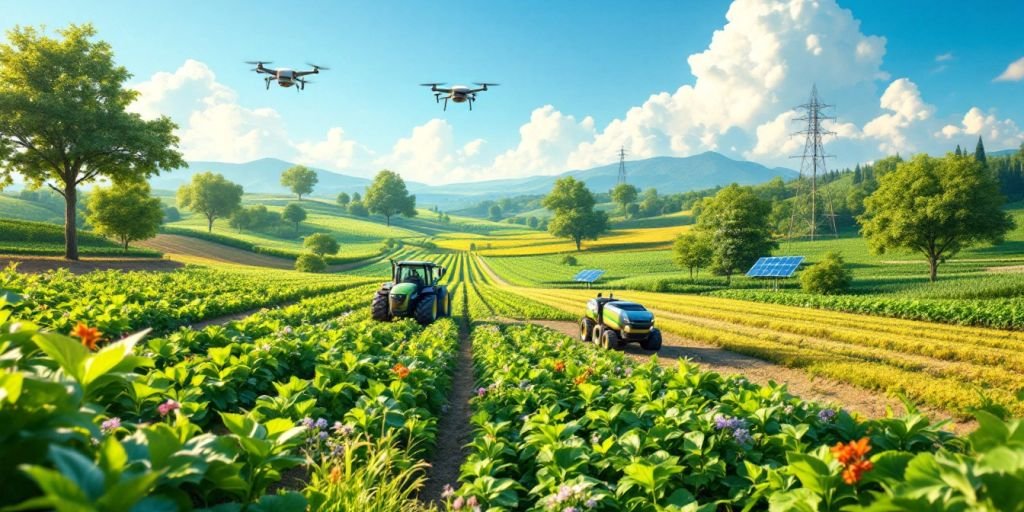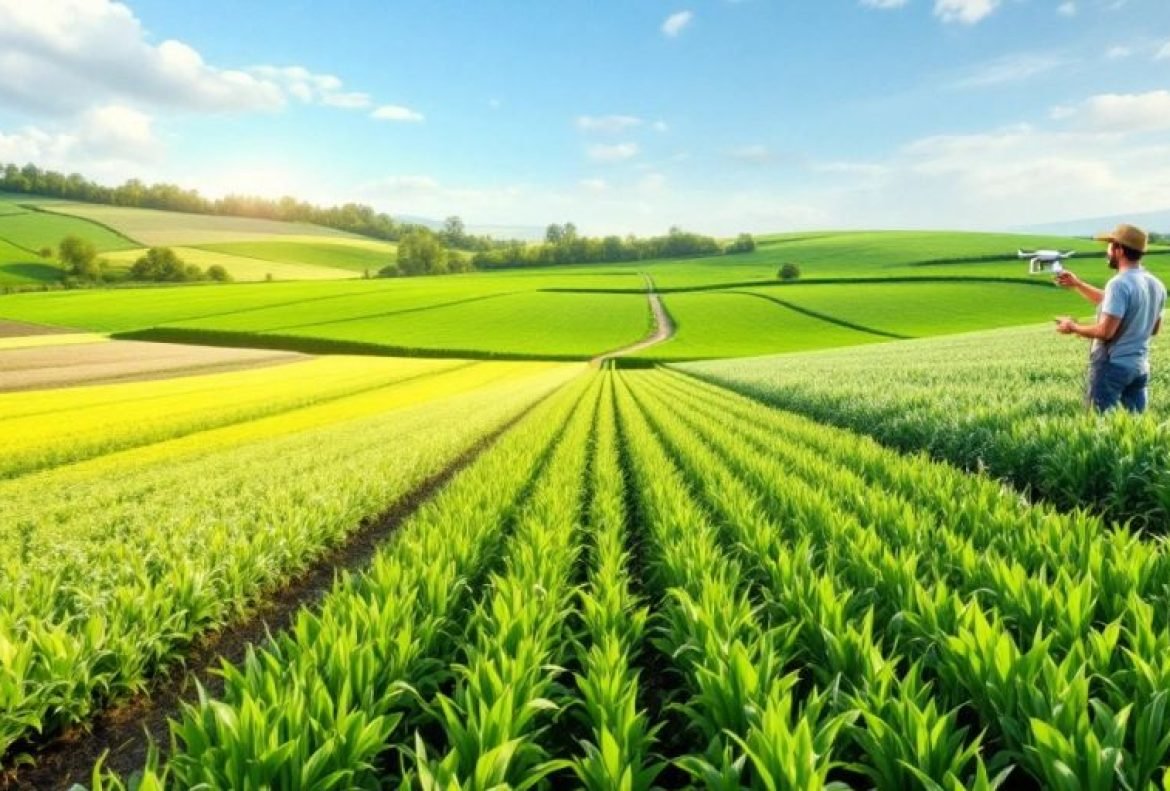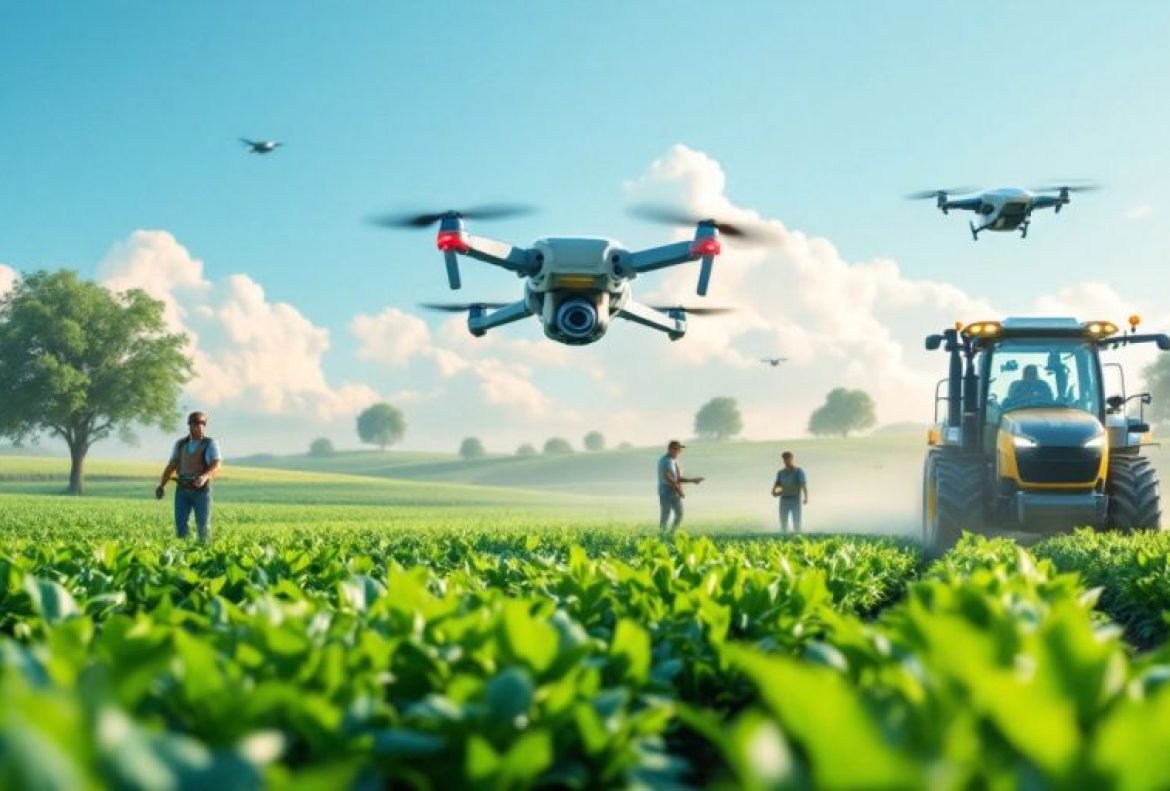Currently Empty: RM0.00
Precision Agriculture: Transforming Farming Practices
Precision agriculture is changing the way we farm. By using advanced technologies like GPS and data analytics, farmers can improve productivity and sustainability. This approach allows for better decision-making and resource management, leading to healthier crops and less waste.
Leveraging Satellite Imagery for Crop Monitoring
Farmers can now use satellite imagery to monitor their fields from above. This technology helps in:
- Detecting crop stress early
- Mapping soil variability
- Predicting yields accurately
For example, a farm using satellite data can identify areas needing more water or nutrients, ensuring that every part of the field gets what it needs.
AI and Data Analytics in Precision Agriculture
Artificial intelligence (AI) plays a crucial role in precision agriculture. It helps farmers analyze data quickly and make informed decisions. Key benefits include:
- Personalized crop management recommendations
- Real-time alerts for pests and diseases
- Optimized resource allocation
With AI, farmers can respond faster to challenges, improving their overall efficiency.
Benefits of Precision Agriculture for Sustainability
Precision agriculture not only boosts productivity but also promotes sustainability. By using resources more efficiently, farmers can:
- Reduce water and chemical usage
- Minimize environmental impact
- Enhance soil health
In summary, precision agriculture is a game-changer for modern farming, making it possible to grow more food while caring for our planet.
"Precision agriculture improves farming by leveraging advanced technologies to enhance productivity and sustainability."
Smart Irrigation Systems: Enhancing Water Efficiency
Smart irrigation systems are changing the way farmers use water. These systems help save water by using real-time data to decide when and how much to water crops. This means less waste and better crop health.
Real-Time Soil Moisture Monitoring
- Sensors check soil moisture levels.
- Data is sent to farmers instantly.
- Helps in deciding the right time to irrigate.
Weather-Based Irrigation Scheduling
- Adjusts watering based on weather forecasts.
- Reduces water use during rainy days.
- Ensures crops get the right amount of water.
Remote Control and Automation of Irrigation
- Farmers can control irrigation from their phones.
- Automation saves time and labor.
- Systems can be programmed to water at specific times.
Smart irrigation systems can lead to water conservation, reduced labor efforts, and improved crop yield. For example, a study showed that these systems can cut water usage by up to 30%.
Smart irrigation is a game-changer for farmers, allowing them to use resources wisely while boosting productivity.
By adopting these technologies, farmers not only enhance their efficiency but also contribute to a more sustainable future in agriculture.
| Feature | Benefit |
|---|---|
| Real-Time Monitoring | Immediate data for decisions |
| Weather Integration | Saves water during rain |
| Remote Control | Convenience and time-saving |
Integrated Pest Management: A Sustainable Approach

Integrated Pest Management (IPM) is a smart way to control pests while being kind to the environment. This method helps reduce the use of harmful pesticides, making farming safer for both farmers and consumers. Here’s how IPM works:
Biological and Cultural Pest Control Methods
- Natural Predators: Using insects like ladybugs to eat harmful pests.
- Crop Rotation: Changing the types of crops grown in a field to disrupt pest life cycles.
- Companion Planting: Planting certain plants together to naturally repel pests.
AI-Powered Pest Detection and Intervention
- Smart Sensors: Devices that monitor pest activity and alert farmers in real-time.
- Data Analysis: Using AI to predict pest outbreaks based on weather and crop data.
- Targeted Treatments: Applying solutions only where pests are detected, reducing waste.
Reducing Chemical Usage in Pest Management
- Lower Pesticide Exposure: IPM significantly lowers the amount of pesticides used, which is crucial for social sustainability in agriculture.
- Healthier Ecosystems: By promoting biodiversity, IPM supports a balanced ecosystem, enhancing soil health and resilience.
- Cost-Effective Solutions: Farmers can save money by using fewer chemicals and relying on natural methods.
IPM is not just about pest control; it’s about creating a sustainable farming future that benefits everyone.
By adopting IPM, farmers can protect their crops while also protecting the environment, making it a win-win for all.
Crop Nutrition Solutions: Optimizing Fertilization
Analyzing Soil Composition for Targeted Fertilization
Understanding the nutrient needs of crops is essential for effective fertilization. By analyzing soil composition, farmers can determine the specific nutrients required for optimal growth. This targeted approach helps in applying the right amount of fertilizer, reducing waste and environmental impact.
Custom Fertilization Recommendations
With advanced technology, farmers can receive customized fertilization plans based on soil health and crop requirements. This ensures that each field gets the precise nutrients it needs, enhancing productivity while minimizing excess fertilizer use.
Minimizing Environmental Impact of Fertilizers
Implementing sustainable fertilizer practices is crucial. Here are some key strategies:
- Use of slow-release fertilizers to reduce runoff.
- Incorporating organic fertilizers to improve soil health.
- Regular soil testing to adjust nutrient application.
Sustainable fertilizer practices aim to maximize crop production while minimizing the negative environmental impact.
By adopting these methods, farmers can not only boost their yields but also protect local ecosystems, ensuring a healthier environment for future generations. Precision in fertilization is key to sustainable agriculture.
Blockchain for Agricultural Traceability

In today’s world, where food safety is a top concern, traceability is essential. Blockchain technology offers a secure way to track food from farm to table. This means every step of the journey can be recorded and accessed easily, ensuring transparency and trust.
Ensuring Food Safety and Quality
- Secure records: Blockchain keeps an unchangeable record of the entire supply chain.
- Quick identification: If there’s a problem, we can quickly find out where it started.
- Consumer confidence: Knowing where their food comes from builds trust with buyers.
Real-Time Product Tracking from Farm to Table
With blockchain, farmers can:
- Monitor their products in real-time.
- Share information with consumers about the journey of their food.
- Respond faster to any issues that arise.
Building Consumer Trust Through Transparency
- Transparency: Consumers want to know how their food is produced.
- Quality assurance: Farmers can show their commitment to quality.
- Market differentiation: Products that are traceable can often command higher prices.
Blockchain is not just a tech trend; it’s a game-changer for the agricultural industry, enhancing safety and trust in food systems.
By adopting blockchain, we can revolutionize how we think about food safety and quality, making it better for everyone involved.
AI-Powered Advisory Systems: The Future of Farming
Personalized Crop Management Recommendations
AI technology is changing the way farmers manage their crops. With real-time insights, farmers can receive tailored advice on what to plant, when to plant, and how to care for their crops. This means better yields and healthier plants. For example, a farmer can get specific recommendations based on their local weather and soil conditions.
Real-Time Pest and Disease Alerts
Farmers can now use AI to detect pests and diseases before they become a problem. By analyzing data from sensors and satellite imagery, the system can alert farmers about potential threats. This proactive approach helps in reducing crop loss and minimizes the need for chemical treatments. Here’s how it works:
- Early detection of pests
- Targeted interventions to save crops
- Reduced chemical usage for a healthier environment
Optimized Resource Allocation Suggestions
AI helps farmers use their resources more efficiently. By analyzing data on soil health, moisture levels, and crop needs, the system can suggest the best times and amounts for watering, fertilizing, and applying pesticides. This leads to:
- Less waste of water and fertilizers
- Cost savings for farmers
- Improved sustainability in farming practices
By leveraging AI, farmers can make smarter decisions that benefit both their crops and the environment.
In summary, AI-powered advisory systems are revolutionizing farming by providing personalized recommendations, real-time alerts, and optimized resource management. This technology not only enhances productivity but also supports sustainable practices in agriculture.
Nanotechnology in Agriculture: A New Frontier
Nanotechnology is changing the way we think about farming. It enhances crop protection, nutrient delivery, and soil management, offering sustainable solutions to address challenges like climate change and soil degradation.
Role of Nanoparticles in Enhancing Productivity
Nanoparticles (NPs) are tiny materials that can improve farming in several ways:
- Improved Nutrient Delivery: Nanofertilizers can deliver nutrients more efficiently to plants, reducing waste.
- Enhanced Pest Control: Nanopesticides can target pests more effectively, minimizing the need for harmful chemicals.
- Soil Health: NPs can help improve soil structure and fertility, leading to better crop yields.
Nanotech-Enabled Devices for Early Warning Systems
These devices can monitor crop health and environmental conditions, providing farmers with real-time data. For example:
- Soil Moisture Sensors: Help farmers know when to water their crops.
- Pest Detection Systems: Alert farmers to pest outbreaks before they become a problem.
- Nutrient Monitoring Tools: Ensure that plants receive the right amount of nutrients at the right time.
Challenges and Opportunities in Nano-Innovations
While nanotechnology offers many benefits, there are also challenges:
- Environmental Concerns: The long-term effects of nanoparticles on ecosystems are still being studied.
- Cost of Implementation: Advanced technologies can be expensive for small farmers.
- Regulatory Hurdles: New regulations may be needed to ensure safety and effectiveness.
Nanotechnology is a promising field that can help us tackle the pressing issues in agriculture today. By leveraging its unique properties, we can create a more sustainable future for farming.
Sustainable Farming Practices: Balancing Productivity and Environment
Sustainable farming is essential for protecting our planet while still producing food. By using smart techniques, farmers can boost their yields without harming the environment. Here are some key practices:
Reducing Water and Chemical Usage
- Implementing drip irrigation systems to minimize water waste.
- Using organic fertilizers to lower chemical runoff.
- Practicing crop rotation to maintain soil health.
Improved Soil Conservation Techniques
- Cover cropping to prevent soil erosion.
- No-till farming to enhance soil structure.
- Regular soil testing to monitor health and nutrient levels.
Carbon Footprint Tracking and Reduction
- Utilizing renewable energy sources on farms.
- Measuring emissions to identify reduction opportunities.
- Engaging in carbon offset programs to balance emissions.
Sustainable farming is not just about growing food; it’s about nurturing the earth for future generations.
By adopting these practices, farmers can create a more sustainable agricultural system that benefits both productivity and the environment. For instance, the Japanese crispy melon from Borneo Fruits Farm showcases how sustainable methods can lead to high-quality produce while preserving natural resources.
In conclusion, balancing productivity with environmental care is crucial for the future of farming. With the right tools and practices, we can ensure a healthier planet and a more secure food supply.
Data-Driven Agriculture: Harnessing Big Data
In the modern farming world, data is essential. Farmers are now using big data to make smarter decisions that can lead to better crop yields and sustainability. Here’s how:
Predictive Modeling for Crop Yields
- Farmers can use data to predict how much they will harvest.
- This helps in planning for storage and sales.
- For example, using weather data can improve yield predictions by up to 20%.
Personalized Farm Management Recommendations
- Data analysis provides tailored advice for each farm.
- This includes specific planting times and crop choices based on local conditions.
- Farmers can adjust their practices to maximize productivity.
Risk Assessment and Mitigation Strategies
- Data helps identify potential risks like pests or drought.
- Farmers can prepare in advance, reducing losses.
- For instance, using historical data can help predict pest outbreaks.
| Data Type | Use Case | Impact |
|---|---|---|
| Weather Data | Crop yield predictions | Up to 20% improvement |
| Soil Composition Data | Tailored fertilization recommendations | Reduced fertilizer use |
| Historical Yield Data | Risk assessment | Better pest management |
By utilizing big data, farmers can enhance their decision-making, leading to more sustainable practices and improved productivity.
In conclusion, data-driven agriculture is not just a trend; it’s a revolution that empowers farmers to achieve sustainable performance in a data-driven world.
Comparative Analysis: Traditional vs. Precision Agriculture
Efficiency and Productivity Comparisons
When comparing traditional farming methods to precision agriculture, the differences are striking. Precision agriculture uses technology to enhance efficiency and productivity. Here’s a quick look at how they stack up:
| Agricultural Practice | Traditional Method | Precision Agriculture Method | Estimated Resource Savings (%) | Estimated Yield Increase (%) |
|---|---|---|---|---|
| Irrigation | Scheduled, uniform watering | Smart, variable-rate irrigation | 20-30% | 10-15% |
| Pest Management | Blanket application of pesticides | Targeted application based on early detection | 30-40% | 5-10% |
| Soil Analysis | Periodic, broad sampling | Continuous monitoring with sensors | 15-25% | 10-20% |
| Fertilizer Application | Uniform application across fields | Variable-rate application based on needs | 25-35% | 10-15% |
| Crop Monitoring | Manual scouting and visual inspection | Satellite and drone imagery with AI analysis | 40-50% (labor) | 15-25% |
Environmental Impact Assessment
The environmental impact of farming practices is crucial. Traditional methods often lead to overuse of resources, while precision agriculture aims to minimize waste. Here are some key points:
- Reduced chemical usage: Precision methods target specific areas, lowering pesticide and fertilizer use.
- Water conservation: Smart irrigation systems adapt to real-time conditions, saving water.
- Improved soil health: Continuous monitoring helps maintain soil quality and biodiversity.
Cost-Benefit Analysis of Farming Techniques
Investing in precision agriculture can seem daunting, but the long-term benefits often outweigh the costs. Here’s why:
- Higher yields: More efficient practices lead to better crop production.
- Lower operational costs: Reduced resource use translates to savings.
- Enhanced sustainability: Practices that protect the environment can lead to better market opportunities.
The shift from traditional to precision agriculture is not just about technology; it’s about creating a sustainable future for farming.
In conclusion, while traditional methods have served farmers for generations, precision agriculture offers a path forward that balances productivity with environmental stewardship. The future of farming lies in embracing these innovative practices.
In the debate between traditional and precision agriculture, it’s clear that both methods have their strengths. Traditional farming relies on age-old techniques passed down through generations, while precision agriculture uses technology to enhance efficiency and yield. If you’re curious about how these approaches compare and want to learn more, visit our website for detailed insights and resources!



